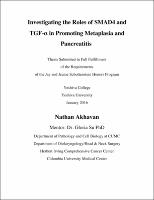Please use this identifier to cite or link to this item:
https://hdl.handle.net/20.500.12202/4177| Title: | Investigating the Roles of SMAD4 and TGF-α in Promoting Metaplasia and Pancreatitis |
| Authors: | Akhavan, Nathan |
| Keywords: | Pancreatitis --Research. Pancreas --Cancer --Research. |
| Issue Date: | Jan-2016 |
| Publisher: | Yeshiva College |
| Abstract: | Pancreatic ductal adenocarcinoma (PDAC) is the most common neoplasm of the pancreas. Despite its low frequency of 6-12 people per 100,000 per year, it is the fourth leading cause of cancer death in the United States. This high mortality rate can be attributed to a lack of early detection methods and effective treatments. Chronic pancreatitis has been shown to be a risk factor for pancreatic cancer and is characterized by fibro-inflammatory changes of the pancreatic tissue. This study sought to create a mouse model that mimics the symptoms of chronic pancreatitis seen in humans associated with PDAC. A suitable model will display a transient state from acinar-ductal meta-plasia (ADM) to PanINs without progressing to cancer. Such a model would provide the chance to examine the precursor to PDAC and potentially pave the way towards designing new treatment options. |
| Description: | The file is restricted for YU community access only. |
| URI: | https://hdl.handle.net/20.500.12202/4177 https://ezproxy.yu.edu/login?url=https://repository.yu.edu/handle/20.500.12202/4177 |
| Appears in Collections: | Jay and Jeanie Schottenstein Honors Student Theses |
Files in This Item:
| File | Description | Size | Format | |
|---|---|---|---|---|
| Nathan-Akhavan.pdf Restricted Access | 10.79 MB | Adobe PDF |  View/Open |
This item is licensed under a Creative Commons License

